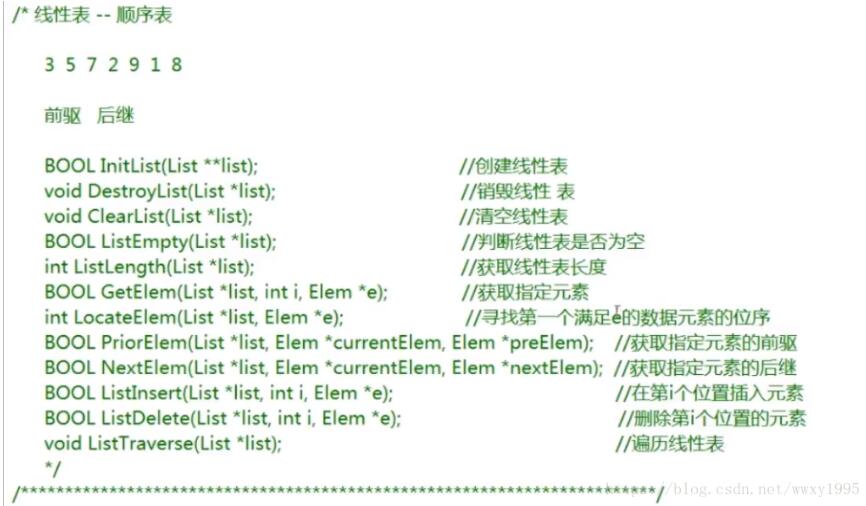本文实例为大家分享了C++类实现线性表的具体代码,供大家参考,具体内容如下
下图是标准C语言实现的函数定义

下面可以用C++实现,第一个参数就是this的指针
list.h函数
|
1
2
3
4
5
6
7
8
9
10
11
12
13
14
15
16
17
18
19
20
21
22
|
#pragma oncetypedef int Elem;class List{public: List(int size); ~List(); void ClearList(); // 将数组长度设为0 bool ListEmpty(); // 判断数组是否为空 int ListLength(); // 获取数组长度 bool GetElem(int i, Elem *e); // 查找指定下标元素 int LocateElem(Elem *e); // 查找指定元素 bool PriorElem(Elem *currentElem, Elem *preElem); // 查找元素的前驱元素 bool NextElem(Elem *currentElem, Elem *nextElem); // 查找元素的后继元素 void ListTraverse(); // 遍历线性表,输出元素 bool ListInsert(int i, Elem *e); // 在指定位置插入一个元素 bool ListDelete(int i, Elem *e); // 删除指定位置元素private: int *m_pList; // 指向一块内存 int m_iSize; // 内存的大小 int m_iLength; // 数组的长度}; |
类的实现,list.cpp
|
1
2
3
4
5
6
7
8
9
10
11
12
13
14
15
16
17
18
19
20
21
22
23
24
25
26
27
28
29
30
31
32
33
34
35
36
37
38
39
40
41
42
43
44
45
46
47
48
49
50
51
52
53
54
55
56
57
58
59
60
61
62
63
64
65
66
67
68
69
70
71
72
73
74
75
76
77
78
79
80
81
82
83
84
85
86
87
88
89
90
91
92
93
94
95
96
97
98
99
100
101
102
103
104
105
106
107
108
109
110
111
112
113
114
115
116
117
|
#include<iostream>#include "List.h"using namespace std; List::List(int size){ m_iSize = size; m_pList = new Elem[m_iSize]; m_iLength = 0;} List::~List(){ delete[] m_pList; // 释放数组内存 m_pList = NULL;} void List::ClearList(){ m_iLength = 0;} bool List::ListEmpty(){ return m_iLength == 0 ? true : false;} int List::ListLength(){ return m_iLength;} bool List::GetElem(int i, Elem *e){ if (i < 0 || i >= m_iSize) { return false; } *e = m_pList[i]; return true;} int List::LocateElem(Elem *e){ for (int i = 0; i < m_iLength; i++) { if (m_pList[i] == *e) { return i; } } return -1;} bool List::PriorElem(Elem *currentElem, Elem *preElem){ int temp = LocateElem(currentElem); // 查找元素的序号 if (temp == -1) return false; else if (temp == 0) return false; else { *preElem = m_pList[temp - 1]; return true; } } bool List::NextElem(Elem *currentElem, Elem *nextElem){ int temp = LocateElem(currentElem); // 查找元素的序号 if (temp == -1) return false; else if (temp == m_iLength - 1) return false; else { *nextElem = m_pList[temp + 1]; return true; }} void List::ListTraverse(){ for (int i = 0; i < m_iLength; i++) { cout << m_pList[i] << endl; }} bool List::ListInsert(int i, Elem *e){ if (i<0 || i>m_iLength) return false; for (int k=m_iLength-1;k>=i;k--) { m_pList[k + 1] = m_pList[k]; } m_pList[i] = *e; m_iLength++; return true;} bool List::ListDelete(int i, Elem *e){ if (i<0 || i>m_iLength) return false; *e = m_pList[i]; for (int k = i + 1; k < m_iLength; k++) { m_pList[k - 1] = m_pList[k]; } m_iLength--; return true;} |
测试主程序
|
1
2
3
4
5
6
7
8
9
10
11
12
13
14
15
16
17
18
19
20
21
22
23
24
25
26
27
|
#include<iostream>#include "List.h"using namespace std; int main(){ Elem temp; Elem arry[11] = { 3,5,7,2,9,1,8 }; List *list1 = new List(10); cout << "length:" << list1->ListLength() << endl; for (int i = 0; i < 7; i++) { list1->ListInsert(i, &arry[i]); } cout << "length:" << list1->ListLength() << endl; // 删除第一个元素 list1->ListDelete(0, &temp); cout << temp << endl; // 搜索前驱元素 list1->PriorElem(&arry[4], &temp); cout << temp << endl; list1->NextElem(&arry[4], &temp); cout << temp << endl; list1->ListTraverse(); delete list1; return 0;} |
以上就是本文的全部内容,希望对大家的学习有所帮助,也希望大家多多支持服务器之家。
原文链接:https://blog.csdn.net/wwxy1995/article/details/83049358














